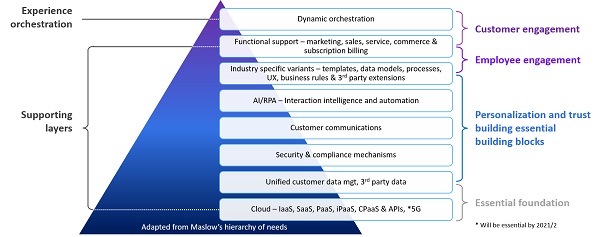Customer relationship management (CRM) applications have been around for several decades, widely adopted to provide functional support for sales, service, and marketing departments. Despite increased sophistication, such applications no longer offer an effective response to the accelerated pace of change or ever-rising customer expectations. While boardrooms across the globe talk about digital transformation, the reality is that most enterprises have struggled to make headway. Merely digitizing one department at a time does not add up to a digital transformation.
This year’s global coronavirus pandemic has highlighted the critical role of digital, whether in supporting remote working or collaborating online via Zoom or other collaborative platforms. Every business must move away from a linear view with the customer at the end of the line. Instead, they must view the customer as the reason for all business activity and, as such, place the customer at the center of all activity. Companies need to develop the capabilities to engage with their customers across a connected network of channels they choose to use throughout all their innumerable journeys, both online and when, safe, in-store. It takes a holistic perspective to orchestrate the most relevant response, action, content, or guidance throughout every step of their journeys. Point solutions, however connected, won’t cut it.
Putting the Customer at the Center of Digital Transformation
Over the last few years, major CRM vendors have been rapidly evolving their CRM applications into customer engagement (CEP) platforms. While the term CEP has yet to enter common parlance, it accurately describes the current development direction.
Back in August 2018, Ovum (now Omdia) conducted the first analysis of these emerging platforms: “Ovum Decision Matrix: Selecting a Customer Engagement Platform, 2018–19.” Few vendors at the time formally referred to their application suites as a CEP, but most agreed that they were trying to tackle the omnichannel customer engagement challenge. Their goal was to develop a means to orchestrate the customer experience from one end of the customer journey to the other, transcending departments and channels through connected workflows, automation, and, increasingly, AI in the form of machine learning and natural language processing.
This development work came with the recognition that many enterprises have multiple point solutions from different vendors; today, they have all adopted APIs as a means to connect diverse systems to form a basis of a customer engagement platform. Naturally, the CRM/CEP vendors would prefer enterprises to standardize on their platforms. Opportunities abound as organizations rethink their customer engagement capabilities and try to develop more resilient, flexible, and adaptable digital capabilities to keep up with change and offset the perils of disruption, whatever the source — microbial, as it has been with COVID-19, or competition for customers.
What Does a CEP Look Like?
While there is no standard architecture for a CEP, the following diagram depicted as a Maslow hierarchy of needs identifies the essential technology layers that culminate in the ability to orchestrate the customer experience dynamically.
Starting at the base are the necessary cloud infrastructure and communications plumbing as an essential foundation. Above that are vital elements to support personalization and privacy/security. Employee engagement is supported by functional capabilities — e.g., marketing, sales, service, commerce, and subscription billing — in support of as-a-service products. There may be industry variants, such as for financial services, healthcare, hospitality, manufacturing, and travel. An effective CEP enables the dynamic orchestration of activities, next best actions, or content and guidance based on inferred intent of the customer and recognition of their individual context.
Lend Your Voice to the Omdia Universe Evaluation of CEPs
In the intervening years since the Ovum study, vendor developments have been rapid and varied. Omdia plans to revisit CEP platforms in a study to be published this September; the upcoming study will include the following vendors: Adobe, Creatio (formerly BPM Online), Microsoft, Oracle, Pegasystems, Salesforce, SAP, ServiceNow, SugarCRM, and Zoho. We’ll be including the voice of the customer in this report, and we would love the No Jitter audience to participate.
How to participate:
If you are using applications for marketing, sales, commerce, or service from any of the above vendors, please
follow this link to TrustRadius and leave a review. This will ensure Omdia gets the vital voice of the user as part of the evaluation. We would also like to hear from organizations that are using any of these vendor’s customer engagement applications as the foundation for their CEP.
Then, this fall watch for a summary of the Omdia Universe study findings.











